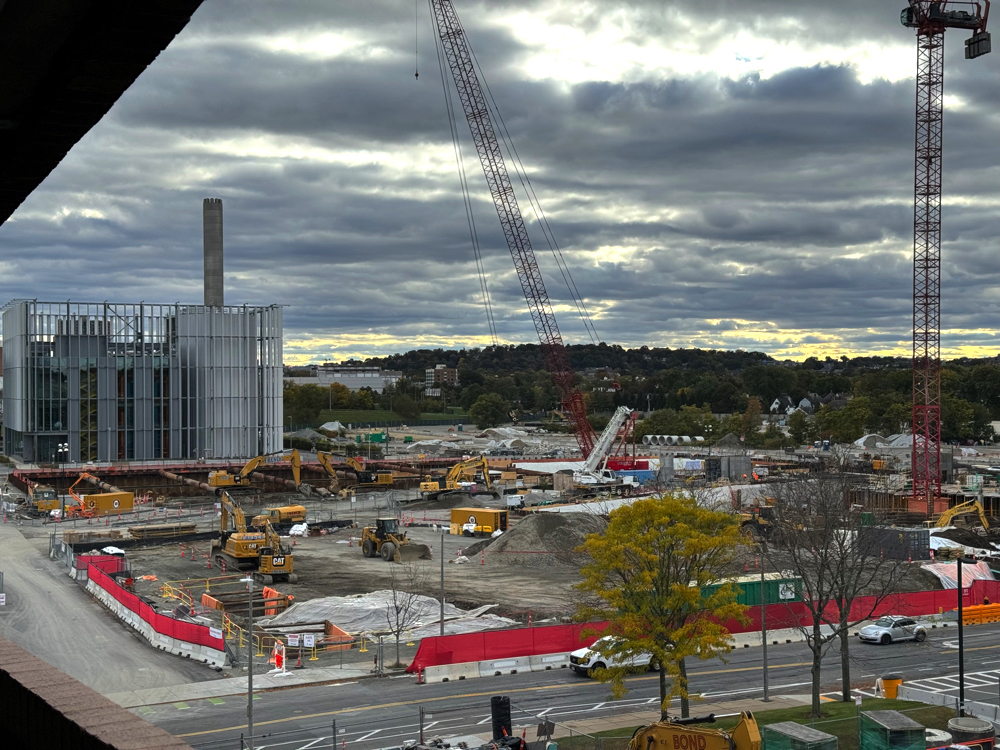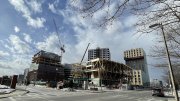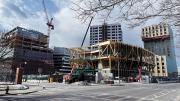The week after a groundbreaking ceremony on the site of the future enterprise research campus (ERC) in Allston, Harvard Magazine spoke with Harvard Allston Land Company (HALC) CEO Carl Rodrigues—the University’s point person for the commercial development on Harvard-owned land. The permitting process for the first phase of the ERC—a six-acre, 900,000-square-foot, multibuilding project on Western Avenue opposite Harvard Business School and adjacent to the Science and Engineering Complex (2020)—has involved complex negotiations among the University, its chosen developer Tishman Speyer, and the local Allston-Brighton community. But for Rodrigues, these types of complex, three-way negotiations are familiar territory. On a terrace of the Science and Engineering Complex, with active construction at the ERC site as a backdrop, he spoke about the similarities between his prior position in New York and his present one at the HALC.
Rodrigues came to Harvard after serving as chief operating officer of the New York City Economic Development Corporation (NYCEDC), where his primary role—working with developers and local communities on city-sponsored projects—was effectuating the vision and policy of the City of New York. “Sometimes that meant more affordable housing,” he says, “sometimes that meant workforce development initiatives.” The ERC project, in which Harvard defined the goals, “is a lot like that”: the University, as part of its requests for proposals (RFPs) wanted “more than just buildings,” he explains. “The $30 million in investments by black and brown investors,” to cite one example, “was an outcome of the RFP process. Through all of the negotiations, you have to triangulate between the goals of the RFP, the community’s goals, and the developer. But you try to start with something that you hope people are excited about.”
The ERC concept, says Rodrigues, emerged in 2011 when an Allston-focused working group suggested that an innovation area in and around the University—like Research Triangle Park in North Carolina or Kendall Square adjacent to MIT—could help enrich the research environment. “Stanford has its own version,” Rodrigues continues, and “all of these university-connected research centers enable industries to explore an idea, consult a professor at the cutting edge of research,” and then return to their labs to see how it all fits together. “You can’t do that without an academic anchor.” (If successful, such projects can also be important parts of the parent institution’s investment portfolio, as Kendall Square is, spectacularly, for MIT. Harvard’s prospects in Allston depend on successor phases of the ERC and, ultimately, development of the much larger acreage now tied up in relocating and reconfiguring the Massachusetts Turnpike—work that is itself likely more than a decade from completion.)
Getting to the start of construction involved a lot of effort to move the project forward, and required both the developer and the University to meet their commitments in a shifting environment. Since the selection of Tishman Speyer as developer, construction costs have risen, and interest rates have increased dramatically. At the same time, negotiations with community leaders and the City of Boston led to a precedent-setting commitment by the developer to designate 25 percent of the residential units in the first phase of development as affordable, and a commitment from Harvard of $25 million. “We try to manage for [these kinds of changes] in a way that is equitable, but also informed by the contract that we signed,” Rodrigues says. But, he continues, “The big picture didn’t change wildly,” which he characterizes as “a testament to Harvard getting a lot of the big picture right. Last week at the groundbreaking, people were really excited about the project. I think that’s a good outcome.”

One of the major challenges the University faces in its aspirations for Allston is the lack of infrastructure. “The University is building out all the utilities, all the streets, all of the open space,” says Rodrigues, and paying for it, something developers like Tishman Speyer and landholders such as Harvard don’t usually do. “It’s usually the public sector that builds the common, public areas,” he says, drawing on his experience in New York.
The upfront infrastructure costs are enormous, he says, “huge numbers.” That’s one of the reasons that Harvard’s 95-year lease agreement with Tishman Speyer is structured a little differently than a traditional ground lease, in which payments are made to the landholder over time. For the ERC, Harvard took payment for the full value of the ground lease upfront, “basically to pay for the infrastructure” that was needed for the project to move forward.
“From the city of Boston perspective, they are getting a landholder to build up public infrastructure.” At the same time, new or minimally taxed property is being added to the tax rolls. “There’s a lot, both from the immediate infrastructure perspective,” and the long-term value that development in Allston will initiate, “that the City is picking up for free.” But returning to the big picture, Rodrigues says that what the University and everybody gets—“the icing on the cake”— is “activation: places to go and things to do” that will bring more people to the area.
Looking ahead, Rodrigues says he expects Tishman Speyer to begin signing tenants during the next 12 months. Because the ERC was envisioned as an innovation center, the University’s hope is that the space will attract a number of small to medium-size companies, to build an “innovation ecosystem.” Such “smaller, more nimble companies are growing so fast,” says Rodrigues, that “they really can’t sign leases two years out [when the ERC is expected to be ready for occupancy], because they might be gone, or they might be 100 percent bigger, or 300 percent bigger. That does not mean that we are not excited about a bigger company coming,” he adds, “but if they come, we would actually in some ways be excited about a toehold—a skunkworks type space,” as opposed to a single large pharmaceutical company taking all 400,000 to 500,000 square feet of lab space in the ERC’s first phase.
In the near term, Rodrigues is focused on ensuring that the opening of this first six-acre phase of the development is successful. That involves negotiation of leases; ensuring that the planning and design work meets the standards that all the parties aspire to; and coordinating the buildout of the infrastructure with city and the developer. At the same time, he is preparing for the formal permitting process for the ERC’s second phase in 2024. Separately, he is working with Boston and its consultant, WXY, an urban planning and design firm that is putting together a master plan for a 50-acre study area bounded by Western Avenue to the North, Cambridge Street to the South, and Soldiers Field Road abutting the Charles River. The area includes the ERC and the greenway that will eventually run from the Honan-Allston branch library on North Harvard street, through the ERC and beyond to the River.
A decade from now and beyond, Rodrigues sees “a tremendous amount of opportunity” for which the planning has not even started. As he point outs, work on the reconfiguration of the Massachusetts Turnpike is not slated to take place until the mid to late 2030s. “That’s today’s best guess. So, you’re talking about stuff happening over there 15, 17 years from now. These are really long timelines.”









